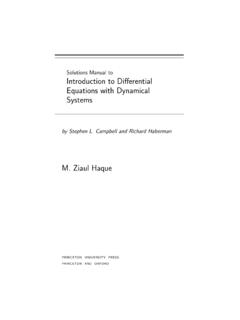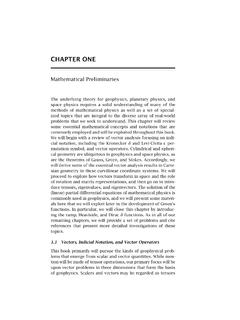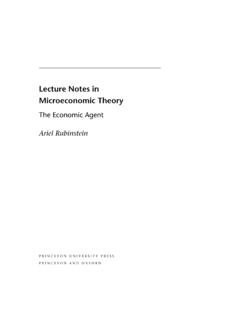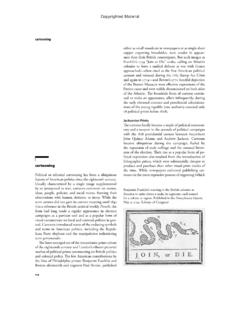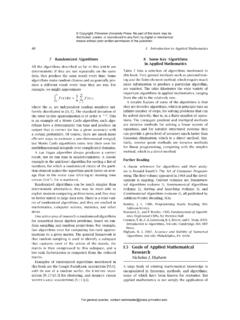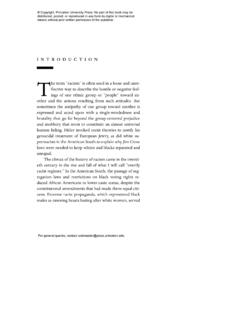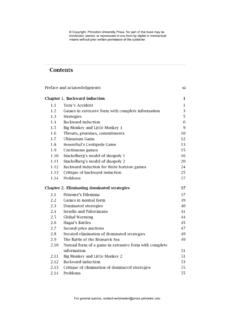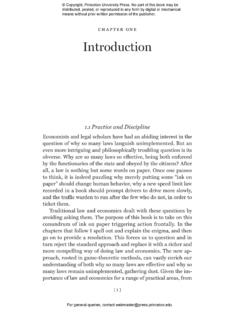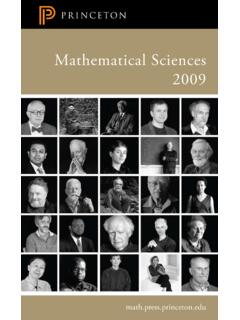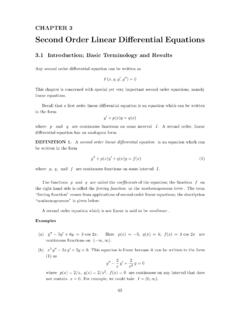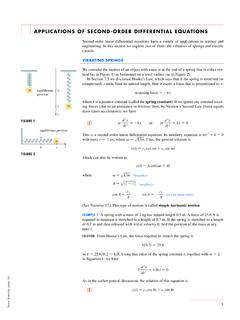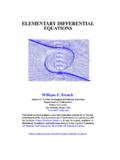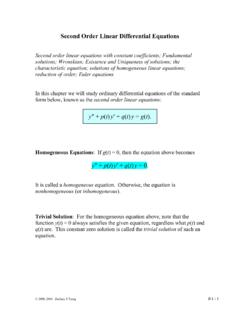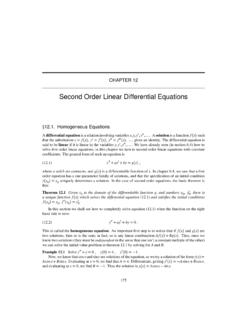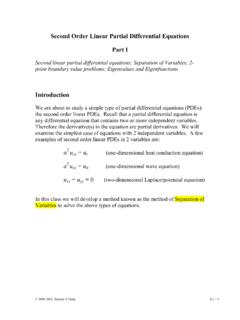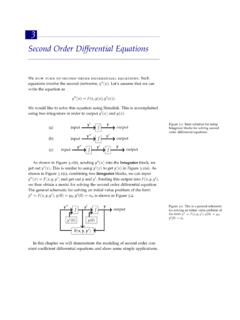Transcription of First-Order Differential Equations and Their Applications
1 CHAPTER 1 First-Order Differential Equations and Their Introduction to Ordinary Differential EquationsDifferential Equations are found in many areas of mathematics, science, and engineer-ing. Students taking a first course in Differential Equations have often already seensimple examples in Their mathematics, physics, chemistry, or engineering courses. Ifyou have not already seen Differential Equations , go to the library or Web and glanceat some books or journals in your major field. You may be surprised to see the wayin which Differential Equations dominate the study of many aspects of science mathematicsinvolves the relationships between mathematics and itsapplications. Often the type of mathematics that arises in Applications is differentialequations. Thus, the study of Differential Equations is an integral part of applied math-ematics. Applied mathematics is said to have three fundamental aspects, and thiscourse will involve a balance of the three:1.
2 Themodeling processby which physical objects and processes are describedby physical laws and mathematical formulations. Since so many physical lawsinvolve rates of change (or the derivative), Differential Equations are often thenatural language of science and Theanalysisof the mathematical problems that are posed. This involves thecomplete investigation of the Differential equation and its solutions, includingdetailed numerical studies. We will say more about this However, the mathematical solution of the Differential equation does notcomplete the overall process. Theinterpretationof the solution of thedifferential equation in the context of the original physical problem must begiven, and the implications further thequalitativeapproach, we determine the behavior of the solutions with-out actually getting a formula for them. This approach is somewhat similar to thecurve-sketching process in introductory calculus where we sketch curves by drawing2 Chapter 1maxima, minima, concavity changes, and so on.
3 Qualitative ideas will be discussedin Section and Chapters 4, 5, and thenumericalapproach, we compute estimates for the values of theunknown function at certain values of the independent variable. Numerical methodsare extremely important and for many difficult problems are the only practicalapproach. We discuss numerical methods in Section The safe and effective use ofnumerical methods requires an understanding of the basic properties of differentialequations and Their of this book is devoted to developinganalyticalprocedures, that is, obtain-ing explicit and implicit formulas for the solutions of various ordinary differentialequations. We present a sufficient number of Applications to enable the reader tounderstand how Differential Equations are used and to develop some feeling for thephysical information they are introduced in more advanced studiesof Differential Equations . Asymptotic approximations are introduced directly from theexact analytic solutions in order to get a better understanding of the meaning of theexact analytic solutions.
4 Unfortunately, many problems of physical interest do nothave exact solutions. In this case, in addition to the previously mentioned numericalmethods, approximation methods known as perturbation methods are often useful forunderstanding the behavior of Differential this book, we use the phrase Differential equation to mean an ordinary differen-tial equation (or a system of ordinary Differential Equations . Anordinary differentialequationis an equation relating an unknown function of one variable to one or morefunctions of its derivatives. If the unknownxis a function oft,x=x(t), then examplesof ordinary Differential Equations aredxdt=t7cosx,d2xdt2=xdxdt,(1)d4xdt4= a Differential equation is the order of the highest derivative of theunknown function (dependent variable) that appears in the equation. The differentialequations in (1) are of first, second , and fourth order , respectively. Most of theequations we shall deal with will be of first or second Applications , the dependent variables are frequently functions of time, whichwe denote byt.)
5 Some Applications such as1. population dynamics,2. mixture and flow problems,3. electronic circuits,4. mechanical vibrations and systemsare discussed repeatedly throughout this text. Other Applications , such as radioactivedecay, thermal cooling, chemical reactions, and orthogonal trajectories, appear onlyas illustrations of more specific mathematical results. In all cases, modeling, analysis,and interpretation are Differential Equations and Their Applications3 Let us briefly consider the following motivating population dynamics Growth ProblemAssume that the population of Washington, DC, grows due to births and deaths at therate of 2% per year and there is a net migration into the city of 15,000 people peryear. Write a mathematical equation that describes this situation. SOLUTION. We letx(t)=population as a function of timet.(2)From calculus,dxdt=rate of change of the population.(3)In this example, 2% growth means 2% of the populationx(t). Thus, the populationof Washington, DC satisfiesdxdt= +15,000.
6 (4) Equation (4) is an example of a Differential equation, and we develop methods tosolve such Equations in this text. We will discuss population growth models in moredepth in Section and Chapters 5 and a typical application, physical laws often lead to a Differential equation. As asimple example, we will consider later the vertical motionx(t)of a constant s lawsays that the forceFequals the massmtimes the accelerationd2xdt2:md2xdt2=F.(5)If the forces are gravity mgand a force due to air resistance proportional to thevelocitydxdt, then the position satisfies the second - order Differential equationmd2xdt2= mg cdxdt,(6)wherecis a proportionality constant determined by experiments. However, if inaddition the mass is tied to a spring that exerts an additional force kxsatisfyingHooke s law, then we will show that the mass satisfies the following second -orderdifferential equation:md2xdt2= mg kx cdxdt.(7)4 Chapter 1In the main body of the book, we will devote some effort to the modeling process bywhich these Differential Equations arise, as well as learning how to solve these typesof Differential Equations will also see that a typical electronic circuit with a resistor, capacitor, andinductor can often be modeled by the following second - order Differential equation:Ld2idt2+Rdidt+1Ci=f(t).
7 (8)Here the unknown variable isi(t), the time-dependent current running through thecircuit. We will present a derivation of this Differential equation, and you will learn themeaning of the three positive constantsR,L, andC(this is called anRLCcircuit).For example,Rrepresents the resistance of a resistor, and we will want to studyhow the current in the circuit depends on the resistance. The right-hand sidef(t)represents something that causes current in the circuit, such as a problems frequently involve systems of Differential Equations . For exam-ple, we will consider the salt content in two interconnected well-mixed lakes, allowingfor some inflow, outflow, and evaporation. Ifx(t)represents the amount of salt inone of the lakes andy(t)the amount in the other, then under a series of assumptionsdescribed in the book, the following coupled system of Differential Equations is anappropriate mathematical model:dxdt=12+2y100 3x100,dydt=3y100 52y100.(9) The Definite Integral and the Initial Value ProblemThis chapter is concerned with First-Order Differential Equations , in which the firstderivative of a functionx(t)depends on the independent variabletand the given directly in terms oftandx, the Differential equation has theformdxdt=f(t,x).
8 (1)In later sections, we will discuss a number of Applications of First-Order equa-tions such as growth and decay problems for populations, radioactive decay, thermalcooling, mixture problems, evaporation and flow, electronic circuit theory, and severalothers. In these Applications , some care is given to the development of the Differential equation (1) is a function that satisfies the differentialequation for all valuestof interest:dxdt(t)=f(t,x(t))for Differential Equations and Their Applications5 Example That a Function Is a SolutionVerify thatx=3et2is a solution of the First-Order Differential equationdxdt=2tx.(2) SOLUTION. We substitutex=3et2in both the left- and right-hand sides of (2). Onthe left we getddt(3et2)=2t(3et2), using the chain rule. Simplifying the right-handside, we find that the Differential equation (2) is satisfied6tet2=6tet2,which holds for allt. Thusx=3et2is a solution of the Differential equation (2). Before beginning our general development of First-Order Equations in Section ,we will discuss some Differential Equations that can be solved with direct integra-tion.
9 These special cases will be used to motivate and illustrate some of the The Initial Value Problem and the Indefinite IntegralThe simplest possible First-Order Differential equation arises if the functionf(t,x)in (1) does not depend on the unknown solution, so that the Differential equation isdxdt=f(t).(3)Solving (3) forxis just the question of antidifferentiation in calculus. Although (3)can be solved by an integration, we can learn some important things concerning moregeneral Differential Equations from it that will be useful IntegrationConsider the simple Differential equation,dxdt=t2.(4)By an integration, we obtainx=13t3+c,(5)wherecis an arbitrary constant. From this example, we see that Differential equationsusually have many solutions. We call (5) thegeneral solutionof (4), since it is aformula that gives all solutions. Becausexdepends ont, sometimes we use thenotationx(t). Often, especially in Applications , we are interested in a specific solutionof the Differential equation to satisfy some additional condition.
10 For example, suppose6 Chapter 1we are given thatx=7att=2. This is written mathematically asx(2)=7 and calledaninitial condition. By lettingt=2 andx=7 in (5), we get7=83+c,so that the constantcis determined to bec=133. Thus, the unique solution of thedifferential equation that satisfies the given initial condition isx=13t3+133. More generally, we might wish to solve the Differential equationdxdt=f(t),(6)subject to the initial conditionx(t0)=x0.(7)We introduce the symbolt0for the value oftat which the solution is given. Oftent0=0, but in the previous example, we hadt0=2 andx0=7. We refer to (6) withthe initial condition (7) as theinitial value problemfor the Differential equation. Wecan always write a formula for the solution of (6) using an indefinite integralx= f(t)dt+c.(8)Equation (5) is a specific example of (8). If we can obtain an explicit indefiniteintegral (antiderivative) off(t), then this initial value problem can be solved likeExample Explicit integrals of various functionsf(t)may be obtained by usingany of the various techniques of integration from calculus.
